- Home
- Garden Wildlife
- Insects
- Hemiptera
- Pond bugs
Common shore bug Saldula saltatoria
Life cycle
Those pond bugs that live in the water usually place their eggs on submerged foliage or insert eggs in the stems of water plants. Water measurers and pond skaters place their eggs on plants at the water surface, while shore bugs deposit eggs in soil crevices. The immature nymphs resemble the adults, gradually increasing in size and developing adult features as they mature. Most pond bugs overwinter as adults. The underwater species stay in the water but pond skaters and water measurers move away and hide in dense vegetation.
Role of pond bugs in gardens
Pond bugs are mostly predators that feed on a wide range of other pond animals, but are generally not common enough to limit populations of frogs and newts..
Other sources of information
Website
Website of British Bugs
Water bugs recording scheme
Books
Dobson,M. Pawley,S. Fletcher,M. & Powell, A. (2012) Guide to Freshwater Invertebrates Published by Freshwater Biological Association
Savage, A. A. (1989) Adults of the British aquatic Hemiptera Heteroptea: a key with ecological notes. Freshwater Biology Association
Southwood, T. R.E. & Leston, D. (1959) Land and water bugs of the British Isles. Available as a CD-ROM or facsimile book from Pisces Conservation Ltd
Natural England (2015) Commissioned Report NECR188 A review of the Hemiptera of Great Britain: The Aquatic and Semi-aquatic Bugs Dipsocoromorpha, Gerromorpha, Leptopodomorpha & Nepomorpha. Species Status No.24 Available here.
Page drafted by Andrew Halstead, reviewed by Andrew Salisbury, edited by Steve Head
Pond bugs
There are a number of bugs in the order Hemiptera that are aquatic or closely associated with the water surface or pond margins. Their legs are often modified to enable them to swim or walk on the water surface. Several families of hemipterans have independently adopted this habit, at least five can be found associated with garden ponds. Most are predatory, and some tropical species such as the giant water bug Lethocerus can be dangerously toxic to sensitised people.
Species in Britain and Ireland
Although Jennifer Owen's garden had a small front garden pond, she did not sample aquatic bugs. Types of bugs associated with ponds in gardens include:
Water boatmen, The family Corixidae has up to 40 species in Britain and Ireland, and adults are up to 10mm long. Their two hind legs are enlarged with fringes, and used like oars to propel them through the water. Water boatmen species swim ‘right way up’, They are mostly not predatory, feeding instead on aquatic plants and algae which some capture using filterig hairs on their front legs. Males produce a mating "song" by rubbing their front legs against their head. The lesser water boatman Corixa punctata is very common in garden ponds
Water measurer Hydrometra stagnorum. Left: also showing the the floating liverwort Ricciocarpos natans. Right: feeding on an earwig nymph.
Water scorpion, We have two species in the family Nepidae in Britain and Ireland. The water scorpion Nepa cinerea is our largest bug, up to 6cm long, and with a pretty scary appearance. It can in fact deliver a painful stab with its stylets. Water scorpions breath through their "tail" which acts like a snorkel when they are underwater. They don't swim well, and tend to crawl over the shallow pond bottom or over damp vegetation, hunting insects, small fish and tadpoles, which they grab with powerful front legs.
The less common water stick insect, Ranatra linearis, lives among pond weeds, and also uses a snorkel-like siphon at the end of its abdomen. It is large, up to 4cm body length and 7cm including the siphon. It prefers ponds with thick emergent vegetation, and feeds on tadoles and invertebrates.
Common backswimmer Notonecta glauca. Left: photographed from above, showing the dimples causes by the surface tension meniscus at the tip of the abdomen and the middle pair of legs. Right: Underwater photograph with the insect's reflection above on the water surface.
Pond skaters We have 10 species in the family Gerridae in Britain and Ireland. The 8-10mm common pond skater, Gerris lacustris, is often the first insect to colonise a new pond and is easily seen "walking on" open water. Its long slender legs spread its weight, enabling it to hop over the water surface supported by surface tension. This miniscule weight is still enough to create a small inverted meniscus which can catch the light and make the insects more obvious. They hunt above and below the water surface for insects and small invertebrates using their clawed front legs.
Like some other hemipterans, adults can be found with reduced non-functional wings as well as the normal winged forms.
Shore bugs We have 19 species in the family Saldidae, all small (2-8mm) oval bugs with big eyes that live on wet shorelines including estuaries. The common shore bug Saldula saltatoria, occurs on wet mud around ponds and ditches, feeding on small insects. They are up to 6mm long and jump when disturbed.
Lesser water boatman Corixa punctata Water boatman Callicorixa praeusta
Backswimmers Family Notonectidae These are superficially similar to water boatmen, but swim upside down on their backs. They breathe atmospheric air rather than using oxygen dissolved in water, and retain a thin film of air around the body using fine water repellent hairs. At rest, they lie upside down under the water surface film, supported by surface tension.The common backswimmer Notonecta glauca is 2cm long, and a strong predator on invertebrates, tadpoles and small fish. It is the commonest of our four species of backswimmer, but be careful when handling because it can give you a painful stab with its mouthparts.
_(19349498661).jpg)
.jpg)
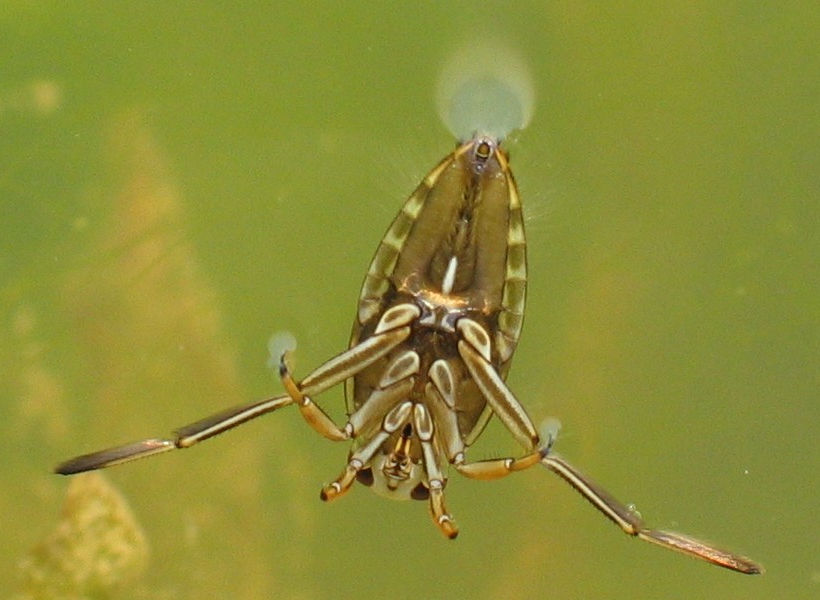
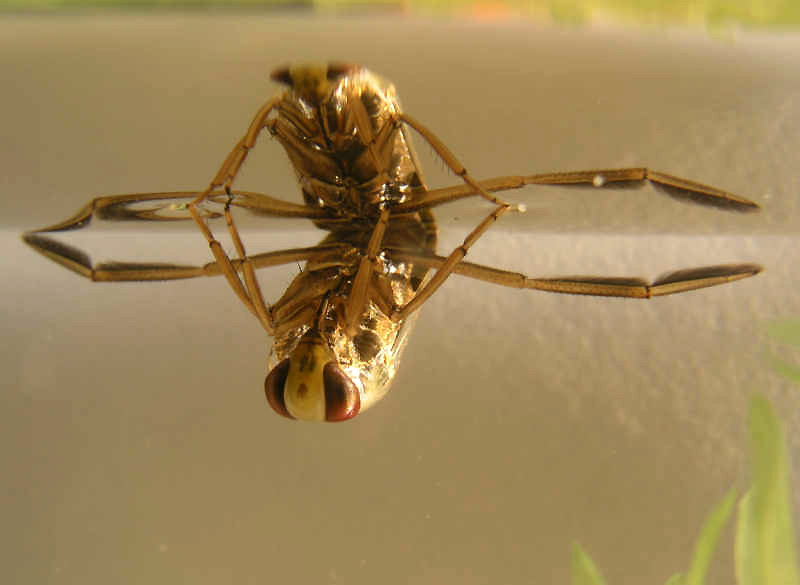
Common pond skater Gerris lacustris. Left: mating pair Right: Showing the dimples made by the water-repellent tips of the legs supported on the surface tension.
Water measurers Family Hydrometridae We have only one hydrometrid bug likely to be found i garden ponds. The water measurer, Hydrometra stagnorum, is a water-walker like the pond skaters, but usually moves slowly and tends to stay amongst surface vegetation, away from open water. It will take dead insects on the water surface, but mainly stalks mosquito larvae and other small invertebrates just below the surface, spearing them through the surface layer. They are usually wingless, but winged individuals are sometimes found.
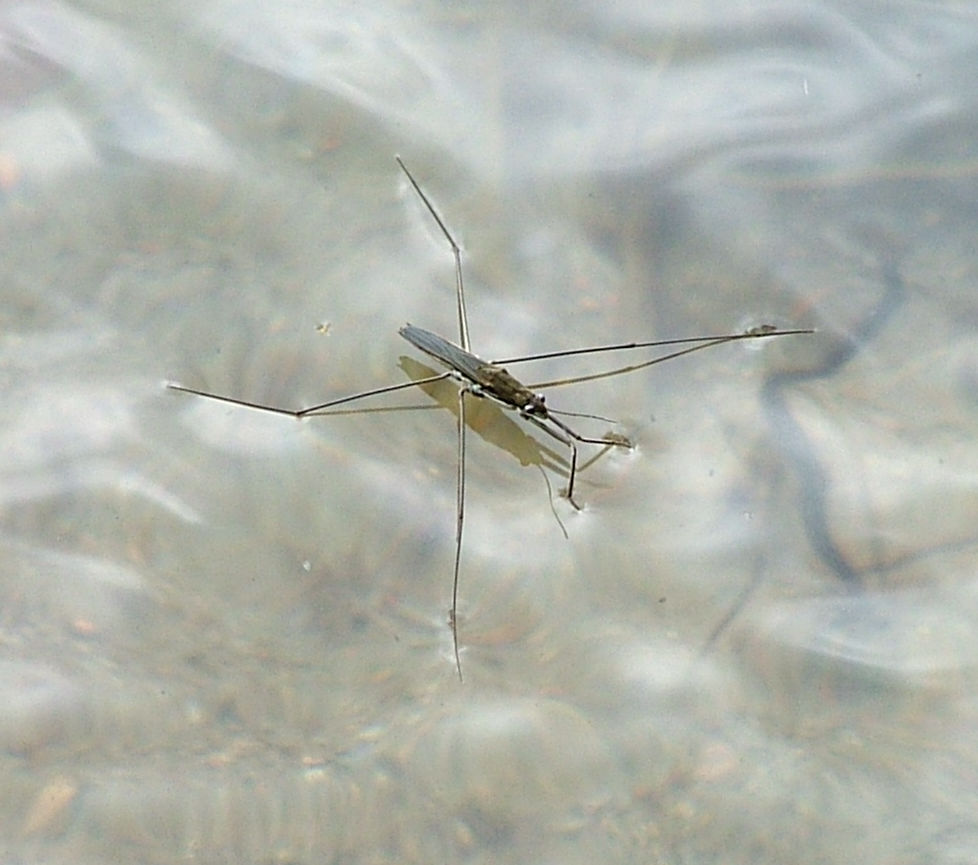
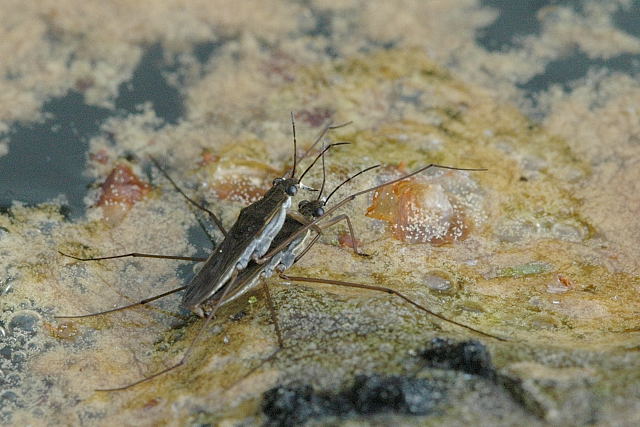
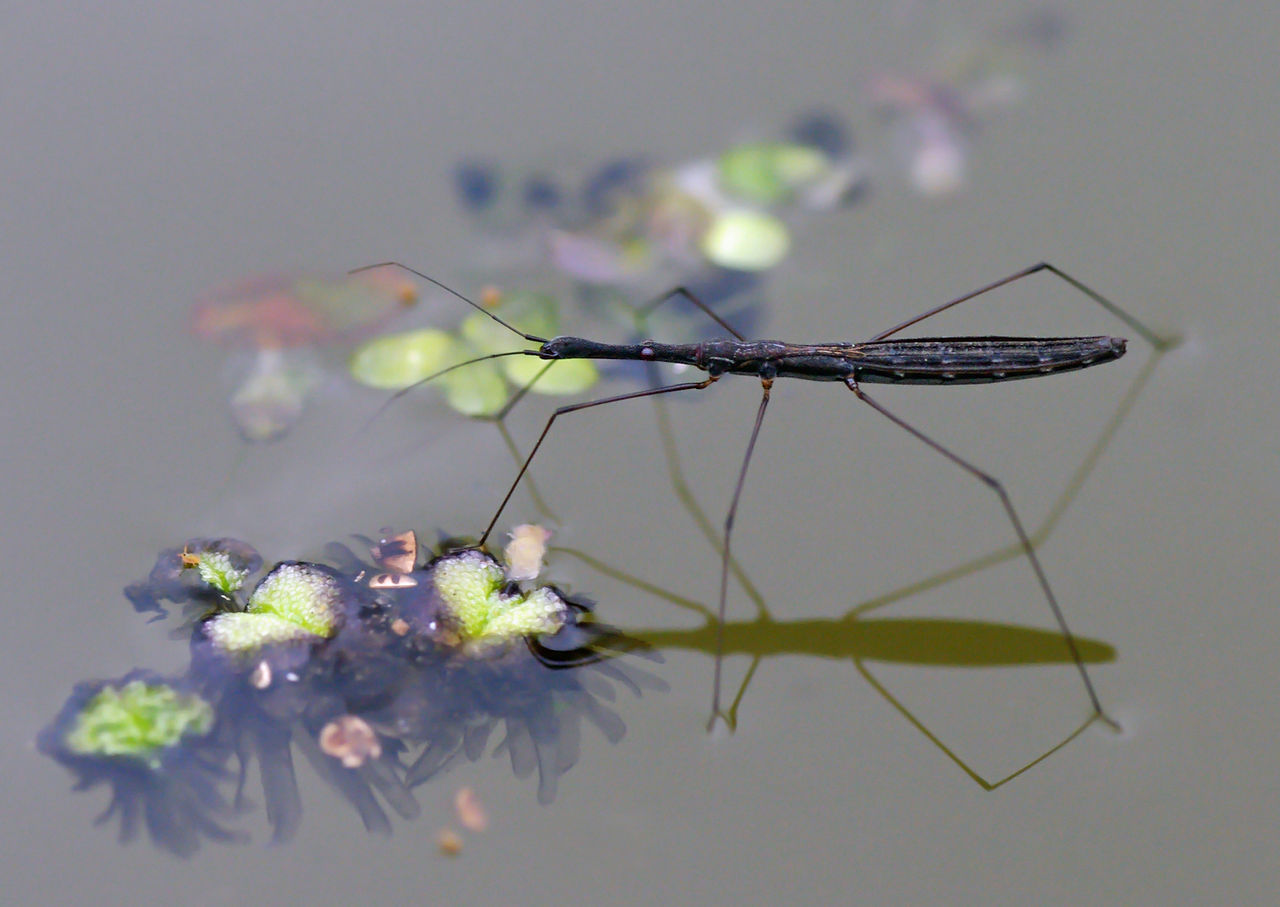
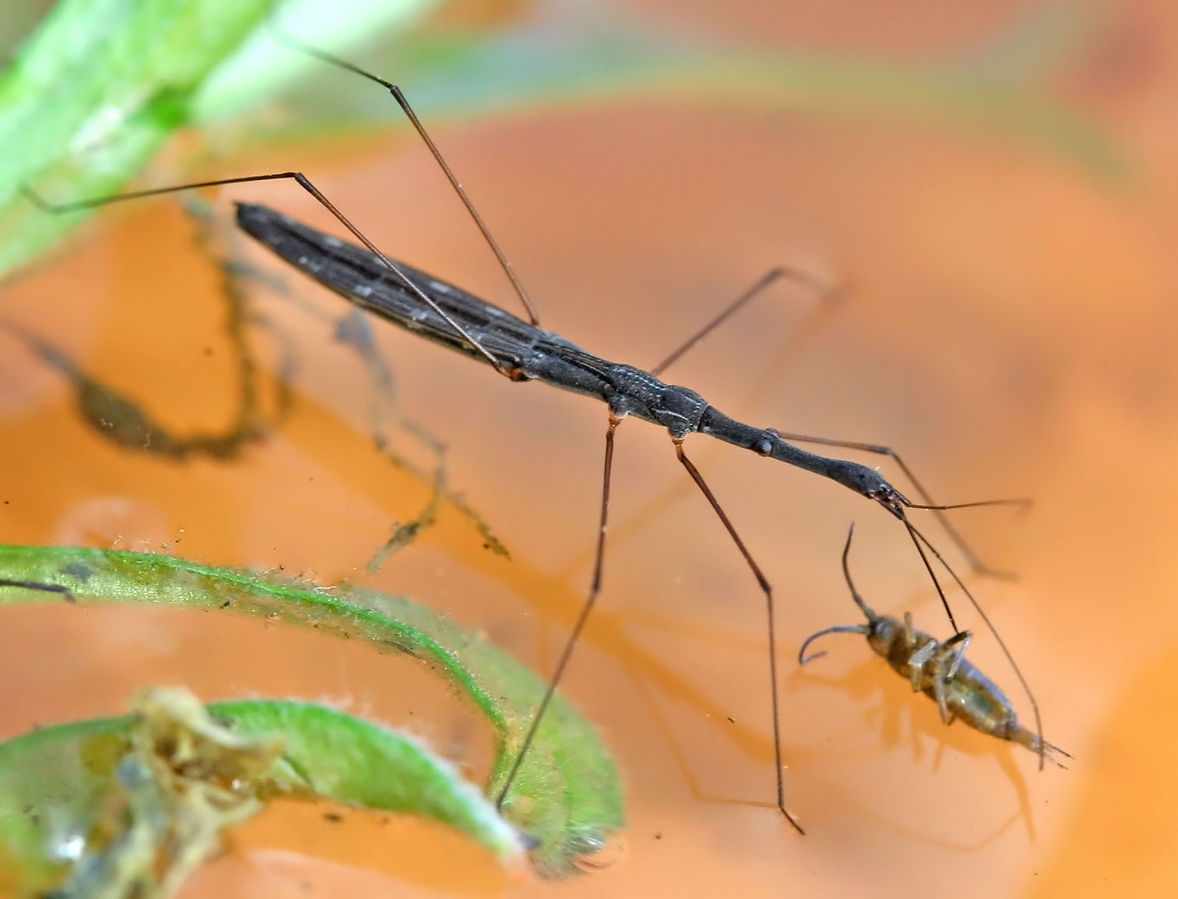
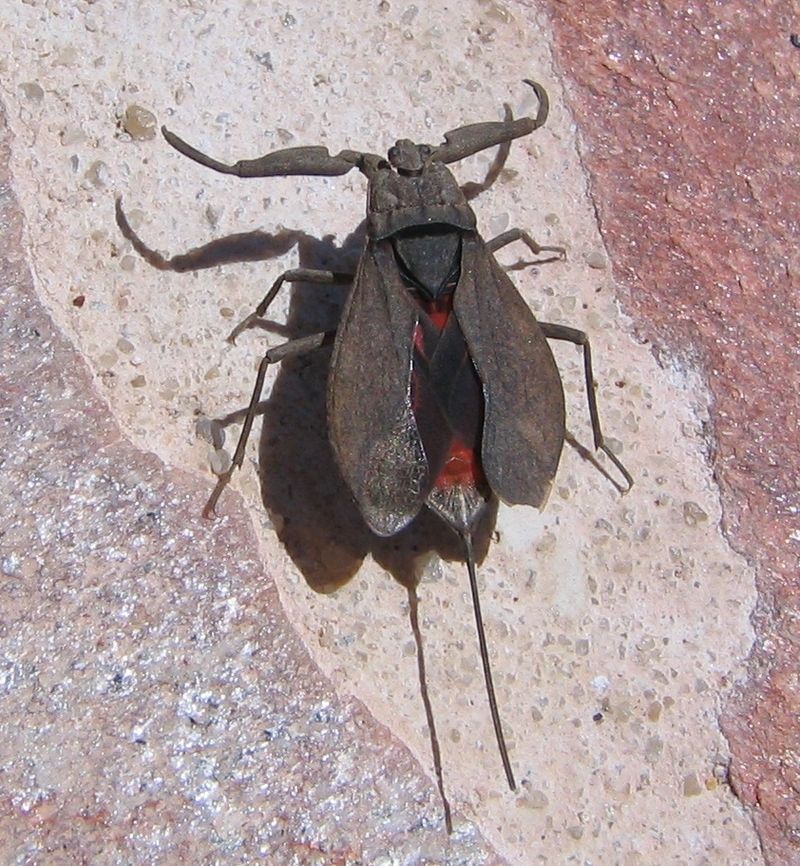
![Water stick-insect Ranatra linearis Photo: Piet Spaans [CC BY-SA 2.5 (https://creativecommons.org/licenses/by-sa/2.5)]](images/RanatraLinearis.jpg)
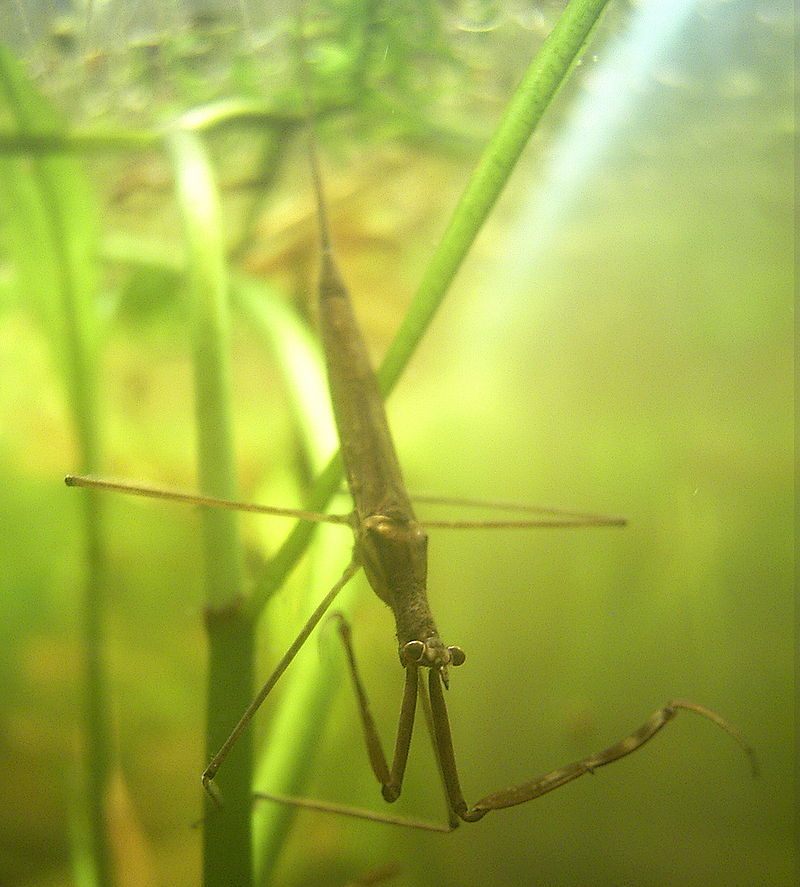
Left: Water scorpion Nepa cinerarea with wings partly open.
Below: Water stick-insect Ranatra linearis showing (left) the exceptionally long body and siphon, and (right) in hunting mode with clawed front legs extended, while still breathing from the water surface.
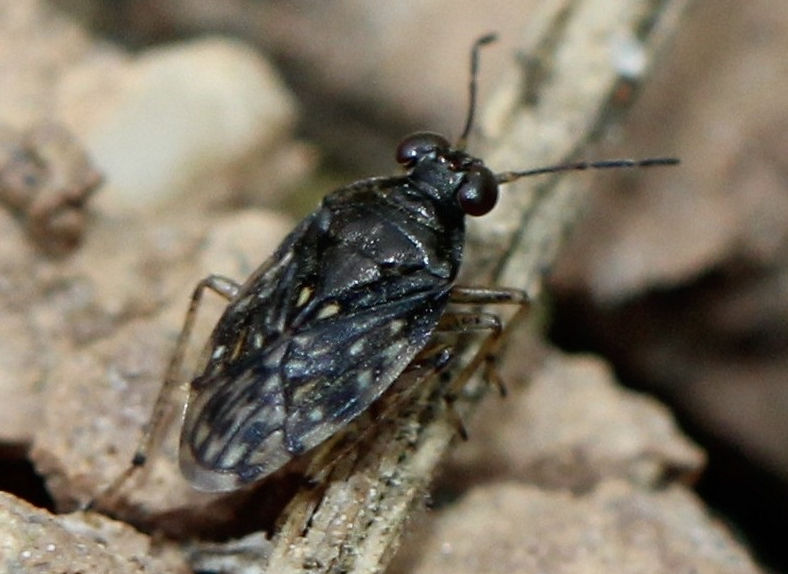

Pond bugs
There are a number of bugs in the order Hemiptera that are aquatic or closely associated with the water surface or pond margins. Their legs are often modified to enable them to swim or walk on the water surface. Several families of hemipterans have independently adopted this habit, at least five can be found associated with garden ponds. Most are predatory, and some tropical species such as the giant water bug Lethocerus can be dangerously toxic to sensitised people.
Species in Britain and Ireland
Although Jennifer Owen's garden had a small front garden pond, she did not sample aquatic bugs. Types of bugs associated with ponds in gardens include:
Water boatmen, The family Corixidae has up to 40 species in Britain and Ireland, and adults are up to 10mm long. Their two hind legs are enlarged with fringes, and used like oars to propel them through the water. Water boatmen species swim ‘right way up’, They are mostly not predatory, feeding instead on aquatic plants and algae which some capture using filterig hairs on their front legs. Males produce a mating "song" by rubbing their front legs against their head. The lesser water boatman Corixa punctata is very common in garden ponds
.jpg)
_(19349498661).jpg)


Common backswimmer Notonecta glauca. Left: photographed from above, showing the dimples causes by the surface tension meniscus at the tip of the abdomen and the middle pair of legs. Right: Underwater photograph with the insect's reflection above on the water surface.
Pond skaters We have 10 species in the family Gerridae in Britain and Ireland. The 8-10mm common pond skater, Gerris lacustris, is often the first insect to colonise a new pond and is easily seen "walking on" open water. Its long slender legs spread its weight, enabling it to hop over the water surface supported by surface tension. This miniscule weight is still enough to create a small inverted meniscus which can catch the light and make the insects more obvious. They hunt above and below the water surface for insects and small invertebrates using their clawed front legs.
Like some other hemipterans, adults can be found with reduced non-functional wings as well as the normal winged forms.
Lesser water boatman Corixa punctata Water boatman Callicorixa praeusta
Backswimmers Family Notonectidae These are superficially similar to water boatmen, but swim upside down on their backs. They breathe atmospheric air rather than using oxygen dissolved in water, and retain a thin film of air around the body using fine water repellent hairs. At rest, they lie upside down under the water surface film, supported by surface tension.The common backswimmer Notonecta glauca is 2cm long, and a strong predator on invertebrates, tadpoles and small fish. It is the commonest of our four species of backswimmer, but be careful when handling because it can give you a painful stab with its mouthparts.


Common pond skater Gerris lacustris. Left: mating pair Right: Showing the dimples made by the water-repellent tips of the legs supported on the surface tension.
Water measurers Family Hydrometridae We have only one hydrometrid bug likely to be found i garden ponds. The water measurer, Hydrometra stagnorum, is a water-walker like the pond skaters, but usually moves slowly and tends to stay amongst surface vegetation, away from open water. It will take dead insects on the water surface, but mainly stalks mosquito larvae and other small invertebrates just below the surface, spearing them through the surface layer. They are usually wingless, but winged individuals are sometimes found.
Water measurer Hydrometra stagnorum. Left: also showing the the floating liverwort Ricciocarpos natans. Right: feeding on an earwig nymph.
Water scorpion, We have two species in the family Nepidae in Britain and Ireland. The water scorpion Nepa cinerea is our largest bug, up to 6cm long, and with a pretty scary appearance. It can in fact deliver a painful stab with its stylets. Water scorpions breath through their "tail" which acts like a snorkel when they are underwater. They don't swim well, and tend to crawl over the shallow pond bottom or over damp vegetation, hunting insects, small fish and tadpoles, which they grab with powerful front legs.
The less common water stick insect, Ranatra linearis, lives among pond weeds, and also uses a snorkel-like siphon at the end of its abdomen. It is large, up to 4cm body length and 7cm including the siphon. It prefers ponds with thick emergent vegetation, and feeds on tadoles and invertebrates.



Left: Water scorpion Nepa cinerarea with wings partly open.
Below: Water stick-insect Ranatra linearis showing (left) the exceptionally long body and siphon, and (right) in hunting mode with clawed front legs extended, while still breathing from the water surface.
![Water stick-insect Ranatra linearis Photo: Piet Spaans [CC BY-SA 2.5 (https://creativecommons.org/licenses/by-sa/2.5)]](images/RanatraLinearis.jpg)


Shore bugs We have 19 species in the family Saldidae, all small (2-8mm) oval bugs with big eyes that live on wet shorelines including estuaries. The common shore bug Saldula saltatoria, occurs on wet mud around ponds and ditches, feeding on small insects. They are up to 6mm long and jump when disturbed.
Common shore bug Saldula saltatoria
Life cycle
Those pond bugs that live in the water usually place their eggs on submerged foliage or insert eggs in the stems of water plants. Water measurers and pond skaters place their eggs on plants at the water surface, while shore bugs deposit eggs in soil crevices. The immature nymphs resemble the adults, gradually increasing in size and developing adult features as they mature. Most pond bugs overwinter as adults. The underwater species stay in the water but pond skaters and water measurers move away and hide in dense vegetation.
Role of pond bugs in gardens
Pond bugs are mostly predators that feed on a wide range of other pond animals, but are generally not common enough to limit populations of frogs and newts..
Other sources of information
Website
Website of British Bugs
Water bugs recording scheme
Books
Dobson,M. Pawley,S. Fletcher,M. & Powell, A. (2012) Guide to Freshwater Invertebrates Published by Freshwater Biological Association
Savage, A. A. (1989) Adults of the British aquatic Hemiptera Heteroptea: a key with ecological notes. Freshwater Biology Association
Southwood, T. R.E. & Leston, D. (1959) Land and water bugs of the British Isles. Available as a CD-ROM or facsimile book from Pisces Conservation Ltd
Natural England (2015) Commissioned Report NECR188 A review of the Hemiptera of Great Britain: The Aquatic and Semi-aquatic Bugs Dipsocoromorpha, Gerromorpha, Leptopodomorpha & Nepomorpha. Species Status No.24 Available here.
Page drafted by Andrew Halstead, reviewed by Andrew Salisbury, edited by Steve Head











